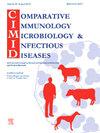Molecular detection and characterization of Leptospira species in bats and other small wild mammals from Villeta municipality, Colombia
IF 2
3区 农林科学
Q4 IMMUNOLOGY
Comparative Immunology Microbiology and Infectious Diseases
Pub Date : 2025-05-09
DOI:10.1016/j.cimid.2025.102355
引用次数: 0
Abstract
Leptospira is a bacterial genus which includes several pathogenic species. Wild mammals can act as reservoir hosts, shedding bacteria in their urine. Leptospirosis is an important health problem in Villeta, but data regarding potential reservoirs hosts and natural sources of infection are still scarce. We aimed to detect and characterize the presence of Leptospira among small wild mammals from Villeta municipality, Colombia. Small wild mammals from three orders: Didelphimorphia, Chiroptera and Rodentia, were sampled in the region. DNA was extracted from kidney samples and screened for Leptospira through real-time PCR targeting a the 16 s rRNA gene. Positive samples were screened through conventional PCR using five complementary genes: adk, icdA, lipL32, lipL41 and secY. Amplicons were sequenced and used for phylogenetic analysis. A total of 75 kidney samples were collected from three small wild mammal orders: 62 bats, 5 opossums, and 7 rodents. Leptospira spp. was detected in 38.7 % of the samples, with bats presenting the most frequent infection rate (43.5 %). The infection rate varied by sampling site, with the highest frequency observed in Mave village (57.1 %). Concatenated phylogenetic analysis revealed that all sequences clustered within the P1/Pathogenic Leptospira major clade, forming three subclades: two bat-related Leptospira subclades, and one subclade including Leptospira interrogans, Leptospira kirschneri, and Leptospira noguchii species. This study describes the presence of Leptospira among bats and opossums from Villeta, Colombia. It also identifies the circulation of several P1/pathogenic Leptospira species among bats forming three clusters, two of them composed exclusively of bat-related leptospires, and one together with recognized pathogenic species.
哥伦比亚维莱塔市蝙蝠和其他小型野生哺乳动物中钩端螺旋体的分子检测和特征
钩端螺旋体是一种细菌属,包括几种致病性物种。野生哺乳动物可以作为宿主,通过尿液排出细菌。钩端螺旋体病是Villeta的一个重要卫生问题,但关于潜在宿主和自然感染源的数据仍然很少。我们的目的是在哥伦比亚维莱塔市的小型野生哺乳动物中检测和描述钩端螺旋体的存在。本地区有双翅目、翼翅目和啮齿目三目野生小型兽类。从肾脏样本中提取DNA,针对16 s rRNA基因进行实时PCR筛选钩端螺旋体。采用adk、icdA、lipL32、lipL41、secY五个互补基因进行常规PCR筛选阳性样本。扩增子测序并用于系统发育分析。采集了蝙蝠62只、负鼠5只、啮齿动物7只等3目动物肾脏标本75份。38.7 %的样本中检出钩端螺旋体,其中蝙蝠感染率最高(43.5 %)。不同采样点感染率不同,以Mave村感染率最高(57.1% %)。所有序列均聚集在P1/致病性钩端螺旋体主分支中,形成3个亚分支:2个与蝙蝠相关的钩端螺旋体亚分支,1个包括疑问钩端螺旋体、克氏钩端螺旋体和野口钩端螺旋体亚分支。本研究描述了来自哥伦比亚Villeta的蝙蝠和负鼠中钩端螺旋体的存在。它还确定了几种P1/致病性钩端螺旋体在蝙蝠之间的传播,形成三个聚集,其中两个完全由蝙蝠相关的钩端螺旋体组成,另一个与公认的致病物种一起。
本文章由计算机程序翻译,如有差异,请以英文原文为准。
求助全文
约1分钟内获得全文
求助全文
来源期刊
CiteScore
4.60
自引率
0.00%
发文量
102
审稿时长
40 days
期刊介绍:
Comparative Immunology, Microbiology & Infectious Diseases aims to respond to the concept of "One Medicine" and to provide a venue for scientific exchange. Based on the concept of "Comparative Medicine" interdisciplinary cooperation between specialists in human and animal medicine is of mutual interest and benefit. Therefore, there is need to combine the respective interest of physicians, veterinarians and other health professionals for comparative studies relevant to either human or animal medicine .
The journal is open to subjects of common interest related to the immunology, immunopathology, microbiology, parasitology and epidemiology of human and animal infectious diseases, especially zoonotic infections, and animal models of human infectious diseases. The role of environmental factors in disease emergence is emphasized. CIMID is mainly focusing on applied veterinary and human medicine rather than on fundamental experimental research.

 求助内容:
求助内容: 应助结果提醒方式:
应助结果提醒方式:


